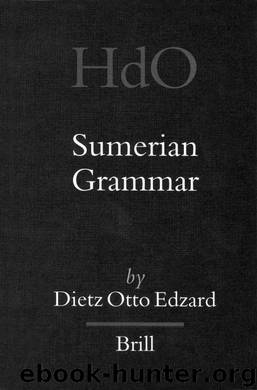SUMERIAN GRAMMAR (Hdo) by DIETZ OTTO EDZARD

Author:DIETZ OTTO EDZARD
Language: eng
Format: epub
Tags: Sumerian; Mesopotamian; Babylonian
the nominalized phrase is in a casus pendens.
See Falkenstein 1956, 63 ff. for the different formulations of "assertorischer Eid" and "promissorischer Eid".
12.16.2. The nominalized phrase is in the genitive
digir-Gu-de-a . . . lu E-an-na in-fu-a-kam [i-n-fu-a-(a)k-am] "it is the
(personal) god of Gudea . . . the one who built the Eana" Gudea
Stat. C i 2-5.
ur-sag-ug 5 -ga i-me-sa-ke 4 -es [i-me-(e)s-a-(a)k-es] "because they (= the
aforementioned mythological beings) are warriors (once) slain (by
Ningirsu)" Gudea Cyl. A xxvi 15.
Note: [imesak] is a free standing genitive to which the adverbiative ending [es] has been added. We cannot give an answer to how [imesakes] was distinguished from a construction mu . . . -a-se (see 12.16.5), i.e., *mu . . . i-me-es-a-se.
enim-ama-ne-ne nu-ub-kiir-ne-a [nu-b-kur-(e)ne-a-a(k)] mu-lugal-bi in-
pa-de-es "they invoked the royal name that they would not change
the (word =) disposition of their mother" NG no. 99:44—46.
Note: In this and in many parallel cases it is not certain whether the nominalized phrase should really be understood as standing in the genitive, resumed by the -bi of mu-lugal-bi, or whether it stands in the absolutive, as a "casus pendens".
12.16.3. The nominalized phrase is in the locative
u 4 d Nin-gir-su-ke 4 sa-ge ba-pa-da-a [ba-n-pad-a-a] "when Ningirsu had (called him in the heart —) chosen him" En. I 2 i 7—ii 1.
The nominalized phrase is in the locative, and there is no geni-tival (regens-rectum) relation between the head (u 4 ) of the phrase and the phrase itself. Therefore, the phrase can only be defined—mor-pho-syntactically—as an apposition or an adjective joined to u 4 . If we see the phrase as an apposition the head (u 4 ) would virtually be in the locative, too, with the locative case particle deleted following a rule that in a sequence of parallel syntactical members only the last one will be marked by a case particle: u 4 (-da) ... -a. Cf. the sequence an ki-a "in heaven (and) on earth" where the locative after an (*an-na = [an-a]) has been deleted: an//ki-a.
If, on the other hand, we see the relation between head (u 4 ) and phrase as a connection of substantive (u 4 ) + adjective (nominalized phrase), there is no need to postulate the deletion of a case particle after u 4 .
By the time of the Ur III dynasty, the separate notation of nom-inalizer [a] and locative case particle [a] often coalesced so that a single written [a] may stand for both. But note still Hammu-rapi bi-in-du„-ga-a RIME 4, 335 no. 2:20.
The u 4 . . . -a construction is extremely popular. In Akkadian it has an exact parallel in the sequence inu/inuma . . . Moreover, the sometimes very elaborate construction u 4 ... (1) ... -a, (2) . . . -a, (3) . . . -a (etc.) u 4 -ba . . . "when . . ., (at that day =) then . . ." (e.g., En. I 20 i 9—iii 2) has its counterpart in Akkadian inu . . . inumisu . . . "when..., then.
Download
This site does not store any files on its server. We only index and link to content provided by other sites. Please contact the content providers to delete copyright contents if any and email us, we'll remove relevant links or contents immediately.
Housekeeping by Marilynne Robinson(4347)
Papillon (English) by Henri Charrière(4195)
The Poetry of Pablo Neruda by Pablo Neruda(4039)
World without end by Ken Follett(3428)
TCP IP by Todd Lammle(3134)
Fluent Forever: How to Learn Any Language Fast and Never Forget It by Gabriel Wyner(3028)
The Rape Of Nanking by Iris Chang(2774)
How Proust Can Change Your Life by Alain De Botton(2742)
The Alchemist by Paulo Coelho(2644)
The Partner by John Grisham(2347)
Two lives by Helen Naylor(2270)
Hitler by Ian Kershaw(2153)
Yerma by Federico García Lorca(2016)
Sophie's World by Jostein Gaarder(1968)
Smilla's Sense of Snow by Peter Hoeg(1907)
Merriam-Webster's Pocket Dictionary by Merriam-Webster(1882)
Twilight of Idols and Anti-Christ by Friedrich Nietzsche(1850)
Il cavaliere inesistente by Italo Calvino(1825)
Deep Writing by Eric Maisel(1784)
